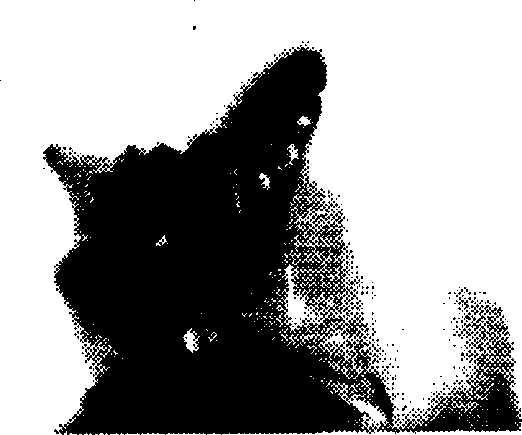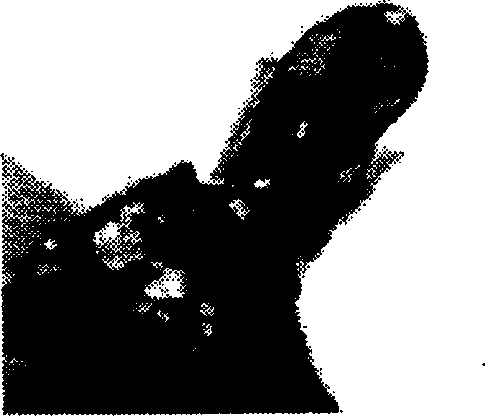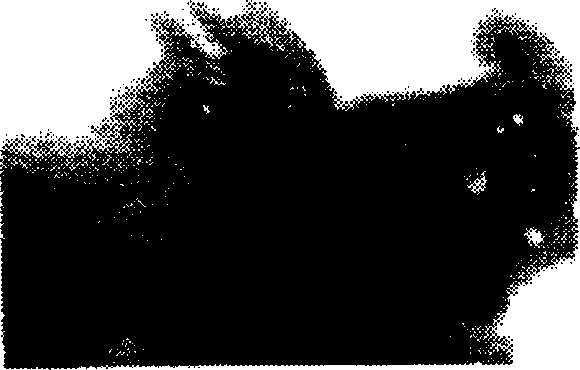Methods for producing denetically modified plants, plant materials and plant products produced thereby
A genetic modification and plant material technology, applied in the field of Eucalyptus and Pinus plants, plant materials and plant products, can solve the problems of low transformation efficiency, low plant regeneration efficiency, long duration of regeneration process, etc.
- Summary
- Abstract
- Description
- Claims
- Application Information
AI Technical Summary
Benefits of technology
Problems solved by technology
Method used
Image
Examples
example 1
[0065] The purpose of this experiment is to determine the best growth period of stem nodes for inducing adventitious buds. The basal medium used was complete Murashige and Skoog (MS) medium (Sigma M5519) containing 30 g / l sucrose. Combinations of stem nodes (apical, first, second, third, fourth) at different growth stages and different concentrations of benzylaminopurine (BA-1, 2, and 3 mg / l) were tested. All media contained 0.01 mg / l naphthaleneacetic acid (NAA).
[0066] The 3-4cm long shoots cultured in vitro were cut into single nodules. Remove all leaves in advance before culturing. Approximately twenty explants were cultured per treatment. Cultures were transplanted to fresh medium every 3 weeks. The development of adventitious buds was assessed after 5 weeks of culture. The rate of adventitious shoot formation on explants for each treatment is listed below.
[0067] Growth period of stem nodes BA concentration
[0068] 1mg / l 2mg / l 3mg / l
example 2
[0076] The purpose of this experiment was to determine the optimal concentration of kanamycin for selection of transformed shoot tissue. The explants were cultured as described at the end of Example 1 in kanamycin concentrations of 0, 5, 10, 25, 50 or 100 mg / l. Cut the 3-4cm long shoots cultured in vitro into single nodules, and select appropriate nodules. Remove all leaves in advance before culturing. Approximately thirty explants were cultured per treatment. After 3 weeks of culture the cultures were transplanted to fresh medium. The percent inhibition of adventitious shoots was determined after 5 weeks of culture. Kanamycin concentration % of nodes forming adventitious buds % inhibition of buds compared to control 0mg / l 80% (24 / 80) 0% 5mg / l 64% (18 / 28) 20% 10mg / l 47 %(14 / 30) 41% 25mg / l 33%(10 / 30) 59% 50mg / l 15%(14 / 31) 81% 100mg / l 3%(1 / 30) 96%
[0077] The highest degree of shoot inhibition was obtained with 100 mg / l of kanamycin. Initial selec
example 3
[0079] The purpose of this experiment was to determine whether pretreatment of stem nodes with cytokinins prior to Agrobacterium infection would increase transformation efficiency. The second and third nodules were pre-incubated on shoot induction medium (MS medium containing 30 g / l sucrose, 1 mg / l BA, 0.01 mg / l NAA) before Agrobacterium infection0,1, 2, 4, or 7 days.
[0080] The 3-4cm long shoots cultured in vitro were cut into single nodules. Use at least 50 nodules per treatment (second and third sections). Cultures were transplanted to fresh medium every 3 weeks. All tissues were stained for GUS activity (Stomp, "Histochemical localization of β-D-glucuronidase", GUS Protocols: using the GUS gene as a reporter of gene expression, pp. 103-113, 1992) as an indication of conversion. Cytokinin Total explants Time of shoot pretreatment of all explants % of GUS positive % of GUS positive
[0081] 0 days 9% (10 / 109) 4% (4 / 109)
[0082] 1 day 3% (2 / 73) 0%
[0083]
PUM
 Login to view more
Login to view more Abstract
Description
Claims
Application Information
 Login to view more
Login to view more - R&D Engineer
- R&D Manager
- IP Professional
- Industry Leading Data Capabilities
- Powerful AI technology
- Patent DNA Extraction
Browse by: Latest US Patents, China's latest patents, Technical Efficacy Thesaurus, Application Domain, Technology Topic.
© 2024 PatSnap. All rights reserved.Legal|Privacy policy|Modern Slavery Act Transparency Statement|Sitemap



